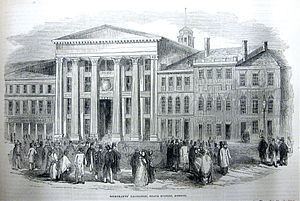Nationality American Occupation Architect | Name Isaiah Rogers Role Architect | |
 | ||
Born August 17, 1800 ( 1800-08-17 ) Marshfield, MA Structures 55 Wall Street, Treasury Building, Old State House, Captain Robert Bennet F, Ohio Statehouse Similar People Alfred B Mullett, George Albert Clough, Robert Mills | ||
Isaiah rogers
Isaiah Rogers (August 17, 1800 – April 13, 1869) was a US architect who practiced in Mobile, Alabama, Boston, Massachusetts, New York City, New York, Louisville, Kentucky, and Cincinnati, Ohio.
Contents
Background
Rogers was born in Marshfield, Massachusetts to Isaac Rogers, a farmer and shipwright, and Hannah Ford. In 1823 he married Emily Wesley Tobey of Portland, Maine. The couple had eight children, four of whom survived infancy. Two of his sons followed him into the profession of architecture.
Rogers was a student of Solomon Willard. He became one of the country's foremost hotel architects and was renowned for Boston's Tremont House (the first hotel with indoor plumbing), the Astor House in New York City and the Exchange Hotel in Richmond, Virginia. He designed the Burnett House in Cincinnati, then the largest and most elegant hotel in the Midwest. He also designed New York's Astor Opera House.
The Cathedral of the Assumption, Louisville, Kentucky was designed in the Neo-Gothic style by William Keeley and Rogers. Upon its completion in 1852, the 287-foot spire was North America's tallest.
His design for the fourth Hamilton County, Ohio Hamilton County Courthouse was for a massive three-story building, measuring 190 feet square. The building bore a close resemblance to Rogers' Merchants Exchange building, Wall Street in New York City. He also designed the Boston Merchants Exchange.
Rogers was the supervising architect, the last of five, who worked upon the Ohio Statehouse. He completed the building in 1861.
in 1853 Rogers founded an architecture firm in Louisville, Kentucky with another architect named Henry Whitestone. That firm was originally named Rogers, Whitestone & Co., Architects and is still practicing today under the name of Luckett & Farley Architects, Engineers, & Interior Designers.
From 1863 to 1865, due to his friendship with fellow Cincinnatian Salmon P. Chase, Secretary of the Treasury, he was Office of the Supervising Architect's Supervising Architect of the United States. In this role he designed and patented four burglar-proof vaults built in the northwest corner of the U.S. Treasury Building in 1864. Their lining consisted of two layers of cast iron balls interposed between the traditional alternating plates of wrought iron and hardened steel. The balls, held loosely in specially formed cavities, were designed to rotate freely upon contact with a drill, or any other tool, thereby preventing a burglar from penetrating. The design was first used for two vaults built in the New York Sub-Treasury, now Federal Hall National Memorial, in 1862. Similar vaults were built in custom houses in Detroit, Cincinnati, and Chicago.
